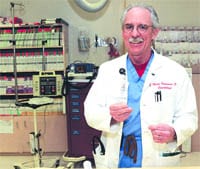Baystate a National Leader in ‘Door-to-balloon’ Time
SPRINGFIELD — It’s called ‘door-to-balloon.’ And those three little words have big implications for patients when it means surviving a heart attack.
Door-to-balloon refers to the time from a heart attack patient’s arrival at the hospital to the moment he or she receives often-life-saving balloon angioplasty or coronary intervention. At Baystate Medical Center, a skilled team of physicians, nurses, EMTs, and other caregivers is saving lives at an impressive pace.
The Centers for Medicare and Medicaid Services, the American College of Cardiology, the American Heart Assoc., and other groups have established 90 minutes or less as the optimal door-to-balloon time for heart-attack patients, the interval in which they have the greatest chance of survival and the best outcomes.
At Baystate, a team approach to accelerating treatment for patients who have a common type of heart attack — referred to as ST-elevation myocardial infarction (STEMI) — has resulted in an average door-to-balloon time of 65 minutes, meaning heart-attack patients receive life-saving balloon angioplasty up to 25 minutes sooner than national guideline recommendations. That time places Baystate among one of the best performers in the state and in the top 10{06cf2b9696b159f874511d23dbc893eb1ac83014175ed30550cfff22781411e5} nationally, as recognized by the National Centers for Medicare and Medicaid Services.
National studies have shown that a greater number of lives are saved when heart-attack patients are quickly treated in a state-of-the-art cardiac catheterization laboratory with the capability to immediately open clogged arteries with angioplasty or stenting. In Western Mass., Baystate is the only hospital providing this technology and expertise.
“Door-to-balloon time is important because we know the quicker we can open the blockage and restore blood flow to the coronary artery, the better the outcome is for our patients,” said Dr. J. Mark Peterman, medical director of the Baystate Regional Heart Attack Program.
“Every minute you wait while having a heart attack means your heart is being further deprived of oxygen, increasing the likelihood and amount of cardiac muscle damage,” he added.
A critical quality measurement, door-to-balloon time begins the second a patient enters the door at a hospital’s Emergency Department. And that means having the staff and technology in place to begin life-saving treatment immediately.
“Our success is a result of a strong partnership between paramedics, Emergency Department physicians and nurses, the staff in Baystate’s Cardiac Catheterization Lab, our interventional cardiologists, and the Cardiac Intensive Care Unit staff,” said Peterman.
Although the clock doesn’t start ticking on door-to-balloon time until the ambulance reaches the Emergency Department, the life-saving scenario begins when patients recognize a problem and call 911 rather than transporting themselves to the hospital. Responding to the 911 call, the ambulance staff can then obtain an electrocardiogram en route to the hospital and alert the Emergency Department, where the team can be prepared for the patient’s arrival.
“Time is muscle when a heart attack is concerned,” said Ann Maynard RN, director of Emergency Services at Baystate, referring to the value of a speedy response in minimizing long-term cardiac damage. Once it is confirmed that the patient is having an ST elevation heart attack, the Cardiac Catheterization Laboratory is activated even before the patient arrives in the Emergency Department. Upon arrival, the patient is examined, stabilized, and brought to the Cardiac Catheterization Lab, where the vessel is unblocked — and the patient’s road to recovery begins.
“The reason we have been so successful in this area is due to the fact we work as a team,” Maynard said. “Everyone knows their role and what needs to be done to ensure the patient is in the cath lab in the best time possible. The team meets monthly to review each case, and to see how we can further improve upon our time.”



Comments are closed.